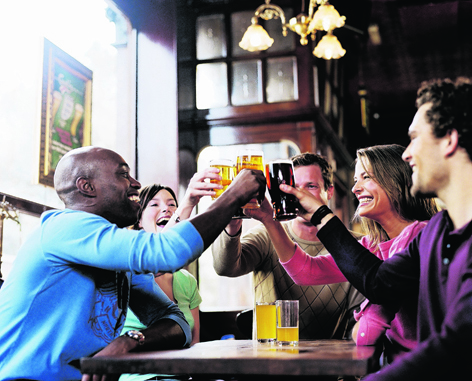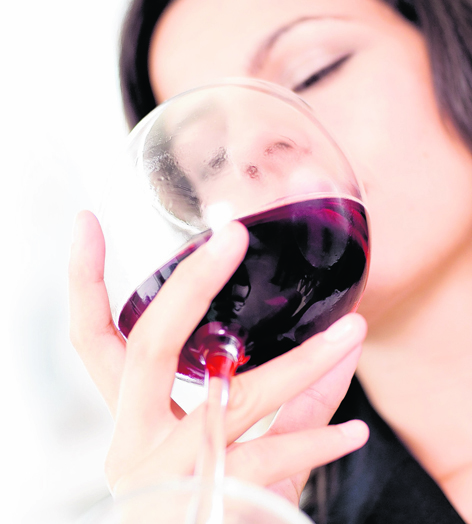Two cans of lager for a man, or two standard glasses of wine for a woman, might not sound excessive – but regularly consuming any more than this means you’re flouting official alcohol guidelines and, yes, possibly damaging your health.
New research has found that many Britons disregard the guidelines, and often because they don’t believe they’re relevant to them as they don’t drink every day, but may drink heavily at weekends.
The findings, from the universities of Stirling and Sheffield for the UK Centre for Tobacco & Alcohol Studies (UKCTAS), have revealed that the guidelines are widely ignored for this reason.
The research has also highlighted how many people think the recommended number of units allowed (UK guidance suggests men shouldn’t regularly exceed three to four units a day, which is equivalent to two cans of regular strength lager; one can is 1.8 units, and women shouldn’t regularly drink more than two to three units daily, equivalent to one 175ml glass of wine; 2.3 units) are unrealistic, as they don’t recognise that many people drink to get drunk.
TIGHT FOR A REASON
While the guidelines might seem stingy, they exist for a reason, as evidence suggests that keeping within these limits means the risk of developing health problems associated with alcohol will be low.
According to experts, people who often drink just above the suggested amount increase their risk of ill-health significantly. For example, some say regularly drinking two large glasses of wine or two pints of strong lager a day could make you three times as likely to get mouth cancer, while regularly drinking just above the guidelines increases the risk of breast cancer by about 20%, and the risk of liver cirrhosis becomes 1.7 times higher.
Despite findings like these, there seems to be a disconnect between the general public and the health risks.
“People are sceptical about Government health advice, and the guidelines, as they’re currently structured, don’t really speak to people’s drinking habits,” says Linda Bould, a professor of health policy at the University of Stirling. “It’s not so much that people think alcohol’s not a problem – about 80% of people in one survey we did, recognised that the UK has a problem with alcohol. But when they think about themselves, they don’t necessarily see a problem.
“The guidelines are useful for giving people some indication of where risk starts. Also, some people really aren’t interested in longer-term health risks,” adds Ms Bould, who suggests that highlighting the more immediate risks of drinking too much, like accidents and injury, could be more effective.
SAVING UNITS FOR THE WEEKEND
The study found that people do regulate their drinking – but this is usually because of practical issues, such as needing to go to work or having childcare responsibilities, rather than health concerns or following guidance.
Ms Bould, who is also Cancer Research UK’s cancer prevention champion, notes that many people think they can save their units for the weekend, but she stresses: “I know that’s wrong.
“If you look at breast cancer, the risk from alcohol consumption starts at a very low level. So a woman who’s drinking a bottle of wine on a Saturday night is at higher risk than a woman who doesn’t drink at all.”
She suggests that drinking half a bottle of wine a night for some women has been normalised in the UK, despite the fact many studies have shown such amounts are damaging.
“I don’t think people really believe it,” she says. “People’s understanding of the risk factors of drinking alcohol and getting cancer are very low – most people don’t think alcohol causes cancer.”
The risks aren’t the same across all diseases, of course. Where heart disease is concerned, studies suggest there’s no significant difference in risk levels between drinking a bottle of wine at the weekend and drinking a few units throughout the week.
“I suppose it depends which condition you’re concerned about,” says Bould. “But if a woman’s drinking two bottles of wine over the weekend, for example, she’s putting herself at higher risk of a pretty significant range of health conditions.”
FLEXIBLE APPROACH
The UKCTAS study found many Brits think Australian and Canadian alcohol guidelines, which include separate advice for regular and single occasion drinkers, are more relevant and flexible.
In the Australian guidelines, the single occasion limits suggest drinking no more than four standard drinks on one occasion reduces the risk of alcohol-related injury. The daily guidance, meanwhile, is to drink no more than two standard drinks a day, for men and women.
The Department of Health says the UK’s alcohol guidance is currently under review, and there will be consultations later this year.
“I think you’ve got to be realistic, certainly in relation to the health harms of alcohol,” says Bould. “In the revised guidelines, which we may see early next year, I think we’ll see a higher unit recommendation over the week – a weekly limit, which is what Australia and Canada have.”
Emily Robinson, deputy chief executive of Alcohol Concern, agrees that many people find the current alcohol guidelines confusing.
“People often see the guidelines as an allowance on what they can drink in a week, when the point is to highlight how it doesn’t take much alcohol to lead to a risk of developing health problems.”
TAKE A BREAK
Rather than focusing on what people can drink, Alcohol Concern suggests there should be more emphasis on taking a break from alcohol, and having at least two or three alcohol-free days a week.
The charity also wants health warnings on alcohol, as is standard in other countries.
Robinson points out that because alcohol impairs judgement and responses, drinkers are also more at risk of having an accident, being assaulted or doing something they’ll regret. And such problems are more likely after binge-drinking, which is officially classed as more than eight units of alcohol (or three pints of strong beer) for a man, or more than six units (or two large glasses of wine) for a woman.
“There is no ‘safe’ level of alcohol consumption,” stresses Robinson.
“The guidelines are a suggested maximum for the public and drinking too much, too often, can cause all sorts of health problems, mentally and physically.”
ALCOHOL HEALTH HARMS
As well as being associated with weight gain and negatively affecting skin, mood and sexual performance, regularly drinking over the lower-risk guidelines is linked with a number of serious health problems, including:
Increased risk of cancer of the throat, oesophagus or larynx
Breast cancer in women
Stroke
Heart disease
High blood pressure
Liver disease such as cirrhosis and liver cancer
Pancreatitis
Reduced fertility
Worried about your own or someone else’s drinking? Call Alcohol Concern’s free, confidential Drinkline on 0300 123 1110 (weekdays 9am-8pm, weekends 11am-4pm).

